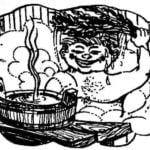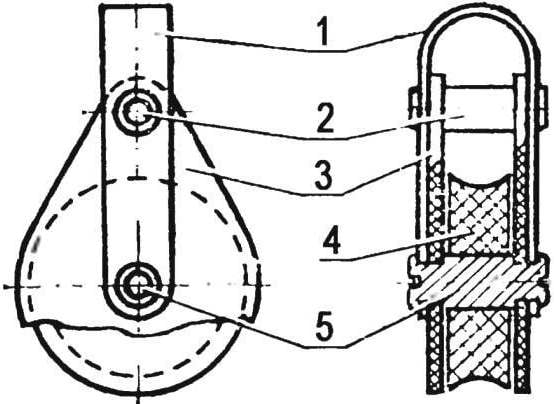Duck is the stand specific forms. They are made of wood, metal or plastic. Gear are attached to them “eight” . Dimensions of ducks depend on the diameter of the cable and applied to it loads.
The jib sheets and main sheets, that is, tackle to control the sails, mounted on the yacht with different stoppers. Structures the great variety of them: Cam, Cam, roller, slotted… But the problem they have a free flowing rope in one direction, to wedge (lock) it when moving in the opposite direction.
One of the most responsible and sensible things of the sailboat block. As you know, the single movable block gives a gain in force twice. To obtain more of the winning blocks are combined into blocks, which are used to control the mainsail. The gain in force is measured by the number of Lapps, that is, the ropes forming the hoist. So, two Scots posting in Lopera gives a two-fold gain in power, and wiring in four or fourfold, respectively.
The design of single-sheave blocks:
1 — weight (steel s1,5 mm); 2 — spacer (steel, brass); 3 — cheek (textolite, getinaks, s4 mm); 4 — pulley; 5 — Nagel (steel)
Fixed Kip:
1 — ring; 2 — clip.
The blocks of different structures are, in General, of the same parts. Unit — plastic or metal pulley — roller with groove, along which moves a cable. The pulley is located between the metal or plastic cheeks and connects with axis (Nagel). If cheeks plastic, the peg is fixed on the wrought — bent metal strip, which is also used for the suspension unit. Structurally, these devices can be single-sheave and mnogochlenami, but as a rule, more than three pulleys in one unit do not unite.
Block sizes are determined by the size of the pulleys. The only thing to consider, that by the use of small diameter pulleys having a large loss due to the bend of the cable, therefore is the best pulley diameter, four to five times the diameter of the used cable. Width of the pulley is chosen such that the cable, moving along the groove does not touch the cheeks. This condition is fulfilled when the width equal to 1.4 — 1.5 diameter of cable.
For posting the running rigging (the Scots) are used bale rings with openings that have rounded edges. They are secured on the hull of the ship still or on the shoulder straps — tilting bars on which they can move. Material for Kip is a metal or plastic (textolite, Micarta, polytetrafluoroethylene). The stationary ring attached to the hull metal straps, and movable mounted on the slide moving on a tilting bracket. This setup gives the ability to change the direction of pull of the mainsheet
Of course this is not a complete description of all fittings used on modern sailing ships, here are only well-established design that is used mainly for tourist sailboats.
Recommend to read
 THE PLANE “RYSACHOK”
THE PLANE “RYSACHOK”
The plane "Rysachok" (including the "extra long" variants) - has a simple and technological design of cheap aluminum alloy. The manufacture and Assembly of all modifications are... STEEL “HEATER”
STEEL “HEATER”
This stove I installed in the bath at their summer cottage. For ten years I use it and is very happy. The furnace body of metal, is welded from a steel sheet with a thickness of 5 mm....
 You built a sailing ship — yacht, Dinghy, catamaran, or simply equipped with a kayak sail. There is no doubt that the main attention was paid to the fabrication of the hull, mast and sails. On a small, inconspicuous at first glance the parts of a sailboat, remember, in the best case, upon completion of its construction or even after the boat in the water and the first trial of sailing. But these details nonetheless are an inseparable part of the vessel.
You built a sailing ship — yacht, Dinghy, catamaran, or simply equipped with a kayak sail. There is no doubt that the main attention was paid to the fabrication of the hull, mast and sails. On a small, inconspicuous at first glance the parts of a sailboat, remember, in the best case, upon completion of its construction or even after the boat in the water and the first trial of sailing. But these details nonetheless are an inseparable part of the vessel.
